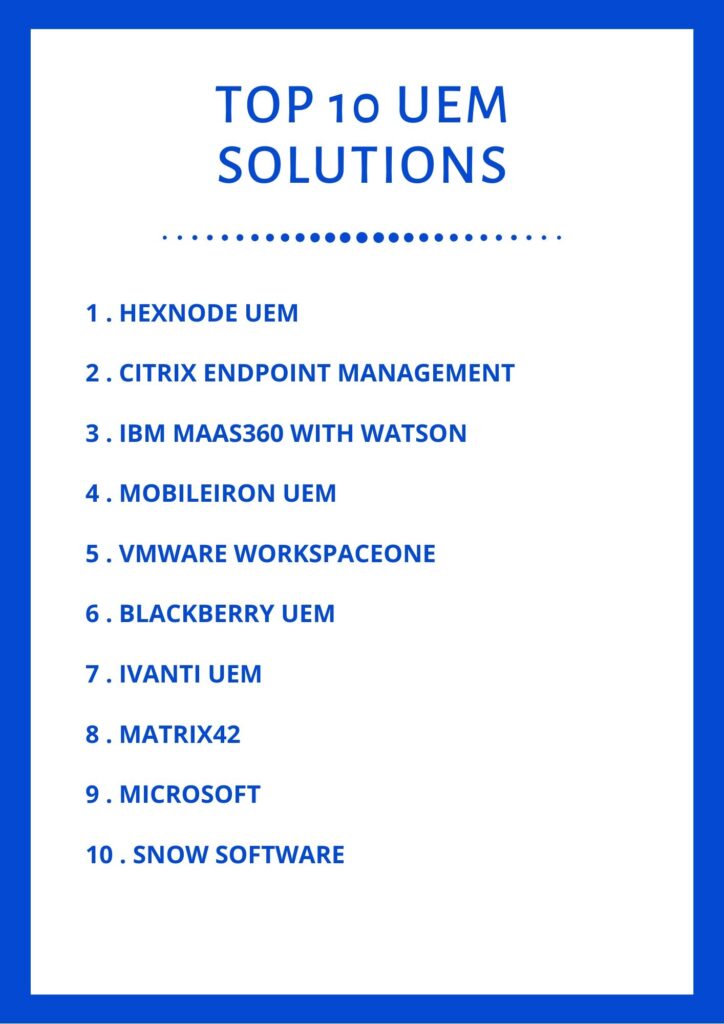Factors to consider while migrating from one MDM to another
Learn about the factors IT admins must consider before switching device management solutions.

Get fresh insights, pro tips, and thought starters–only the best of posts for you.
Noel Rivera
Apr 7, 2020
12 min read

Unified Endpoint Management is swiftly becoming the future of device management. Many organizations that are planning to manage thousands of endpoints are looking for a perfect, tailor-made UEM solution for them. So here is a comprehensive list of the 10 best UEM solutions for everyone who is looking for the right UEM solution for you.
Recognized as a Gartner Peer Insights Customers’ Choice for Unified Endpoint Management (UEM) tools twice in 2019, Hexnode is the gold-standard in unified mobile, desktop, and workplace IoT management. What makes this solution stand out is the breadth of features and a user-first implementation. Legacy UEMs offer great features but miss out on the pragmatic design. Niche vendors focus on usability but lack prime management capabilities. Hexnode offers the best of both UEM worlds and that too at *1.08$ per device per month.
Hexnode works across platforms like iOS, iPadOS, macOS, tvOS, Android, Windows, Amazon FireOS and more. Zero-touch enrollment options across multiple platforms make device onboarding and user provisioning a seamless affair. Added to that, support for OEMConfig and IoT ready devices such as Apple TV gives this solution an edge over its alternatives.

Feel like switching to Hexnode? Here's a helping hand to make your shift to Hexnode as smooth as butter. Make sure you check all the boxes!
Download resource kitAdvanced device configurations, restrictions and app management capabilities of Hexnode are unparalleled. Admins can push device settings, security restrictions, apps and even in-app configurations to the targeted devices. App catalogs offer an easy way to feature store-apps and in-house apps for end-user installation. Admin can also set essential apps as mandatory apps and custom-defined for different users or device groups.
Pricing: *Starts at $1.08 per device per month.
Formerly known as XenMobile, Citrix’s endpoint management software was first launched in 2013. At the time of its launch, Citrix Endpoint Management had MDM and MAM capabilities. At the moment, Citrix has expanded the capabilities of the software to match the rising industry requirements. Often more than not, these capabilities are weighed down by the clunky UI and tedious app life-cycle process.
Citrix’s UEM can be used as a standalone solution but it functions better in a Citrix based infrastructure. It would fit like a glove in organizations that have already invested in Citrix virtualization technology and Citrix FileShare. For organizations that don’t have such an infrastructure should consider other alternatives before opting for Citrix.
MaaS360 with Watson is the UEM offering of IBM. It was developed under the IBM Cloud and Cognitive Sofware division. Several adjacent IBM products that deal with Mobile Threat Defense (MTD), Security Information and Event Management (SIEM) and Identity as a Service (IaaS) have been combined with this UEM solution to give a much more holistic device management experience.
Watson AI integration provides key analytics and risk assessments to the customers. These are provided in the form of highly intuitive reports. The filters present in these reports are customizable and they help in identifying and rectifying any issues present in the managed devices.
IBM also offers key Client Management Tool (CMT) functionalities, which include co-existence and migration.
IBM’s UEM offering is perfect for large scale organizations that are looking for a cloud-based UEM solution. If you are a small-scale organization, IBM MaaS360 might not be the right solution for you.
MobileIron is an established player in the device management front. They provide a highly scalable UEM solution that gives special priority to a strong security suite. MobileIron has also launched modern management features across various platforms. These features which were once pushed as separate products, now come together in the MobileIron UEM solution. It essentially bridges the gap that exists between Client Management Tools (CMTs) and Unified Endpoint Management (UEM).
But even though MobileIron is trying to shed its image as an MDM provider, people still view them as an MDM specialist. This is mainly due to the fact that their UEM solution is not as platform-centric as many other vendors out there. Customers are looking for solutions that provide exemplary functionalities across various platforms and MobileIron just doesn’t cut it in this regard.
Pricing: Starts at $4 per device per month.
When it comes to the device management industry, VMWare is basically a rockstar. They have a great brand and product recognition which makes their UEM solution, WorkspaceONE, a highly sort after product. The key offering of WorkspaceONE is obviously its UEM suite, but VMWare has managed to couple the product with various complementary solutions like VMWare’s Client and application virtualization, in some tiers.
VMWare has also integrated earlier Client Management Tool offerings such as patch management to help bridge the gap between CMTs and UEMs.
WorkspaceONE is a great tool for organizations that are looking to make the switch from Client Management Tools to Unified Endpoint Management.
Pricing: $3.78 per device per month
The UEM offering by BlackBerry is built upon the company’s reputation for high–security mobiles. Modern management of Windows 10 devices and macOS Sierra has been incorporated in this UEM solution.
But one of the key integrations that Blackberry has done with this solution is wearables and IoT devices management. Especially in the IoT front, with several parallel products like BlackBerry spark IoT communication platform, BlackBerry is a formidable vendor.
Blackberry is perfect for organizations looking for secure mobility, collaboration, IoT device management and modern management of traditional desktop pcs.
Ivanti UEM formerly known as LANDesk Management Suite focuses on device management and mobile security. The UEM solution on offer here is a combination of both EMM and CMT capabilities. This provides a “single pane of glass” management for all endpoints in an organization. Ivanti essentially offers a full CMT solution as a part of its UEM software, one of the few vendors out there who actually do that.
As far as features go, there is actually nothing special going on with this UEM solution. License management, remote control management, inventory management, monitoring, and reporting are a few of the features on display here.
Ivanti is a good fit for organizations that are looking for a gradual shift to modern management. But then again, this solution only thrives in an Ivanti products-based environment.
Matrix42’s UEM solution combines traditional client management with mobile security and endpoint management. Owing to its strong presence in the mobile security industry coupled with good brand recognition, Matrix42 has managed to earn a bit of clout in the device management industry.
Matrix42’s offering, while it excels in what it does, is nothing to write home about. It would be a good fit for an organization looking for basic UEM functionalities but doesn’t stress on automated CMT migration.
Microsoft’s Intune is offered as a core component of the Enterprise Mobility + Security Suite (EMS). This later became the foundation for Microsoft’s UEM strategy. Intune, through a two-way integration, was combined with System Center Configuration Manager(ConfigMgr) to create Microsoft Endpoint Manager. This was born out of the growing need to combine Traditional Desktop Management and Mobile Device Management.
One can argue that Microsoft’s UEM offering is not as robust as the other solutions present in this list. It is widely used because it comes with the Office365 EMS bundle. To be honest, it excels at managing Windows 10 devices, which is not surprising. However, if you plan to add other platforms into the mix, it would be better to look elsewhere.
Pricing: Starts at $8.74 per user per month as part of Microsoft’s Enterprise Mobility+Security suite.
Snow software doesn’t provide a UEM solution as such. It is much more of an integrated approach. Snow provides the MDM solution called Snow Device Manager, which is coupled with various sets of products offering different UEM capabilities.
By combining device management, hardware lifecycle management, and software license management, Snow Software has created quite the niche for themselves. And when it comes to CMT migration, Snow does have a migration process in place, but it is very basic when compared to its alternatives.
